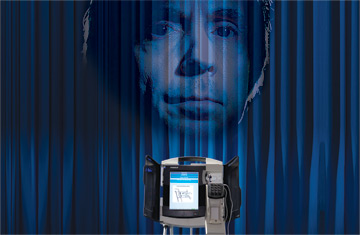
Despite a spotty past, Internet activist Brett Kimberlin has played a central role in the debate over electronic voting.
(3 of 4)
But Kimberlin isn't all talk. In December 2005, he posted a call for Diebold stockholders to participate in a class action being prepared by lawyers with whom he was in contact. Kimberlin found the lead plaintiff; a judge has yet to rule on the validity of the class. The case alleges that Diebold defrauded shareholders by knowingly downplaying problems with its e-voting business.
Kimberlin channeled several reports of balloting irregularities in the 2006 elections that were sent to his websites to a voting-reform group that used them to challenge the use of Diebold machines in California, where the group brought a case against Diebold, alleging that the company infringed voters' rights by producing machines that can't reliably count their vote. The case has yet to be tried. And movement leaders credit him with helping mobilize supporters for petition drives pressuring members of Congress to support voting reform. The key to Kimberlin's success has been the credibility of those who have put his raw material to use. Last September that approach paid off big.
WHILE KIMBERLIN AND OTHERS were mixing fact and fiction in the blogosphere, organizations with more power and authority were grappling with the challenges of e-voting too. Some studies have found that e-voting reduces ballot errors by preventing voters from voting too many times or not enough in individual races. But the errors e-voting does produce often can't be caught because most electronic machines don't keep a reliable, independent record of the vote as it occurs. Asked to do a recount, a paperless e-voting machine will simply spit out the previous result. That, combined with the machines' vulnerability to tampering, says the American Enterprise Institute's Ornstein, has the potential to produce "a genuine, deep crisis of legitimacy," which is precisely what is happening in Florida 13.
In consultation with computer scientists at Stanford University and elsewhere, Congressman Holt, a Democrat and former professor of physics at Swarthmore College, has drafted a bill requiring that all e-voting machines come equipped with a device that produces a printed receipt showing a voter his or her choices before disappearing into storage, to be retrieved in the event of a recount. That bill is gaining momentum on Capitol Hill, thanks, Holt's office says, to the emergence of "concrete proof" of e-voting's shortcomings. Exhibit A is the so-called Princeton Report, published in September.
In mid-2005 a new activist emerged from Kimberlin's network. This time, the person had something of objective value: a pair of Diebold AccuVote TS voting machines, acquired through his job in the e-voting industry. Although e-voting- machine makers claimed their products were secure, no independent academic had managed to dissect an actual machine to check the assertion. Kimberlin called Professor Avi Rubin of Johns Hopkins University, who had written about vulnerabilities in Diebold's e-voting source code after it was inadvertently left on a public server. "When Brett first contacted me, he seemed surprised that I didn't recognize him," Rubin says. "He said, 'It's Brett with Velvet Revolution,' and I felt like, 'Oh, boy, let's figure out how I can get off of this call.'"
